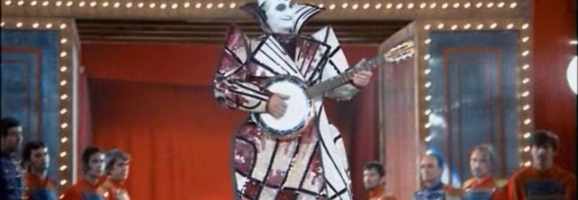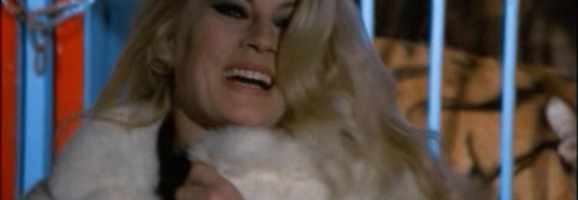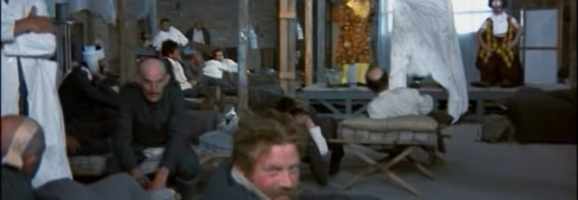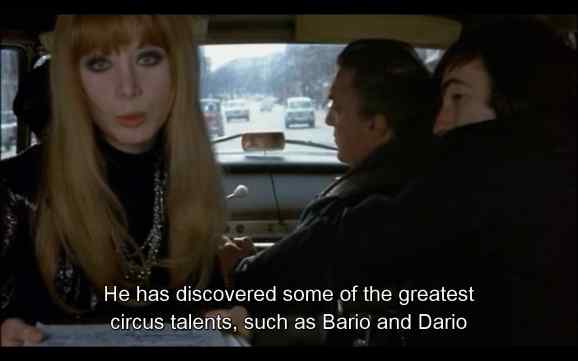I clowns: Fellini’s Mockumentary
Years ago, I read an Amazon user review for Italian filmmaker Federico Fellini’s Satyricon (1969), a grossly underrated, haunting vision of a film, in which the reviewer cited Fellini as the “creator of the mockumentary.” I wasn’t sure what the reviewer was referring to, though, but with a bit of sleuthing, figured out what he was talking about.
This was my first encounter with the film I clowns (1970).
I clowns (The Clowns in English) was a tiny project for Fellini, especially compared to his bombastic, expansive films. Fellini had entered into an agreement with RAI-TV to make a film to be broadcasted on television, with only a small theatrical release afterward. The film explores the fascination and almost existential qualities of clowns and circuses, and follows Fellini (who appears in the film as himself) and his crew as they track down and interview clowns across Europe.
The film and its history instantly sparked my interest, and over the next few months, tracked it down at a mom and pop DVD store. I was ready to see if Fellini had indeed “created the mockumentary.”

Some clarification: a mockumentary, a portmanteau of the words “mock” and “documentary,” is a genre of film or television that seeks to present fictional events in a documentary style to parody the style.
The most common (and popular) type of mockumentary is a humorous one, with the American comedy rock film This is Spinal Tap (1984) being one of the first major films in the genre. The style has also become one of the most utilized styles in American comedy television, with Parks and Recreation, Modern Family, The Office, as well as Arrested Development all featuring elements of the mockumentary. We can also cite the Beatles’ A Hard Day’s Night (1964) and Woody Allen’s Take the Money and Run (1969) as important precursors to the genre, playing with varying degrees of reality.
There is also the qualification “docufiction” (not to be confused with docudrama), which is, essentially, a documentary with added fictional elements, that needs to be noted. Docufiction typically utilizes both direct cinema and cinéma vérité techniques to both capture reality and introduce fictional additions to the
I clowns is an episodic film, as viewers are treated to small pieces of interviews with famous clowns, footage of performances, segments with Fellini and crew, as well as a fantasy narrative that depicts a young boy’s experience with the both eerie and tantalizing circus. The boy seems to symbolize a young Fellini, with his obsession with the circus and with clowns, and the audience gets a kaleidoscopic taste of some clownish characters in the boy’s town.
The transition between the fantasy narrative (which makes up the first segment of the 92-minute film) and the Fellini documentary on the history of clowns is jarring, but not quite abrupt, as Fellini here is as dreamlike as always. The fictional narrative blends well into the documentary, and the boy and Fellini, while not seamless, seem parallel. Fellini uses his “indulgent” film narrative techniques throughout the entire film, crashing images and dialogue together, blurring the real and the dreamlike, as if the film were one of his fictional tour de forces rather than a short documentary.
This approach to filmmaking raises the question: is Fellini’s I clowns an early mockumentary, or perhaps a docufiction, or something else entirely?
Fellini employs a cinéma vérité style throughout the entire film, with himself and many camera operators present on the actual film. The film is often seen through a lens that is behind a camera in the shot that is filming the action, and many shots focus on Fellini directing.
Because of this heightened sense of the real, it is often tough to gauge which scenes are indeed completely real, partly improvised, or completely orchestrated. While most of the scenes in the film are straightforward, many are also wildly edited and fantastic.

In one scene, actress Anita Ekberg, a well-known Fellini star, is seen buying a panther from a circus. It cannot be read whether or not the actress, Anita Ekberg, is playing herself or actually being herself, and the fact that she is known for starring in Fellini’s films only confuses the issue further. It’s an absurd scene, and it could be completely non-fictional, but the way the actress speaks and the wild, sensationalist editing, is so over the top that the scene can’t be real, can’t it? It is obvious Fellini is directing, as per the particular editing, but how far his directing goes is unknown.
In another memorable scene, Fellini captures on film a clown troupe performing for mental patients in a monastery, and while one patient ends up having to be restrained for interrupting the performance, many other patients stare directly into the camera, similar to how characters stare into the camera in many other Fellini films, including 8½ (1963) and Satyricon.
It’s certainly jarring as the characters in each of these films confronts the viewer directly, a Fellini trick to create an uncomfortable, bold, and dreamlike atmosphere. But in the earlier films, the audience knows for a fact that Fellini purposefully addresses the viewer with these haunting sets of faces. Here, in I clowns, these patients are not supposed to be read as actors but as legitimate, non-fiction patients.
It would not be a stretch to say that the patients are indeed real and were merely distracted by Fellini and his crew. However, as per the rest of the film, if this were the case, the audience would see a patient interacting with a camera from the view of a second camera. This does not happen, meaning that these patients (whether or not they are real patients does not matter too much) are being directed by Fellini to act in a certain way. This then seems to mean that the film is closely related to the docufiction genre, however, the audience cannot know (or even guess) what exactly is still real and what is fabricated.

The history of the clowns is educational and factual, though it is difficult to track down the exact clowns Fellini interviews to know if the interviews are completely real or also staged. The interviews are mild, and certainly seem real, and perhaps some portions are real and some exaggerated.
Like most documentaries, Fellini’s has a thesis, though it shifts and is somewhat obscured by the narrative. Throughout the film, Fellini explains that his documentary explores the history of clowns and circuses, but also the fact that “no one knows how to laugh” anymore, as all contemporary people are essentially clowns. Fellini in the film seems to fully be behind this notion and takes it seriously.
Contrary to this lofty goal, though, is a scene in which Fellini is being interviewed by a journalist who poses the question to Fellini, “what’s the film trying to convey?” As Fellini clears his throat to answer the question genuinely, two comically timed buckets fall onto the heads of both the journalist and Fellini, effectively shutting them both up. Fellini in the film is serious, but Fellini the director, the real one, is still something of a prankster, and here scoffs at the idea of the film having a lofty message.

Still further, the film does explore the haunting transitory nature of the circus, how it mysteriously comes and goes, the dual nature of sadness and laughter the clown represents, and the already anachronistic circus aesthetic that barely translates into the modern culture. It’s a sad film, a funeral dirge (toward the end of the film, there is a clown funeral) for the circus that fascinated Fellini and inspired his work, but also an intensely humorous one, as the clown acts are comedy gold and well-performed. The film’s thesis is buried upon layers of meaning and parody-meaning, and Fellini the character and Fellini the director cannot agree upon it.
Like 8½, and although it is billed as a documentary, I clowns is a film about Fellini’s obsession with his childhood psychology, his young hopes and fears, and dreams. It’s a personal film hidden behind the history of the clown, but Fellini’s touch and his self ooze out of each scene.
In a way, it is similar to A Hard Day’s Night, in that the line between reality and fiction are blurred, as the Beatles play themselves in a realistic way, in a realistic world. Yet, that film is not a documentary, instead a comedy with an obvious script (written by the talented Alun Owen) that audiences know is derived from reality but does not seek to portray it.
I clowns is difficult to pin down. Although not a purposeful Italian/English bilingual pun, it is poignant that the film is titled I clowns, as Fellini himself seems to be saying, more than anything, that he is one of the clowns, that he aspires to be the biggest one. He is indebted to the circus, its theatricality and sense of spectacle, and acts as the dual clown here and in his other films, both in constant mourning and in constant celebration.
And here, Fellini pulls a minor prank on us, his audience, a short, televised film in the guise of a documentary that in actuality is a large, psychological exploration of his childhood wonders.
It would be unfair to claim that Fellini is being insidious here, though, in today’s world of reality tv and Catfish. He goes to great lengths to teach the history of the clowns, the whiteface clowns, and the red-nosed auguste clowns, and to explore the universal meaning of clowns. He has a deep affection for them, and by the end, even those with a disposition against clowns will have a more personal relationship with them.

In a way, I clowns is the most Fellini of all of Fellini’s films. It has such a heightened sense of the real and unreal, fantasy and dreams, and is boldly extravagant where extravagance has never been before. It is plotless, meandering, episodic, and hallucinatory, a sensory, fleeting vision of feeling and longing rather than a film with a structured plot or agenda.
It remains one of Fellini’s less seen and talked about films, and even those with a discerning eye for Fellini could go unfazed by it. Yet, I clowns is an outlier among its mockumentary and docufiction brethren, ripe for study, as well as an interesting footnote in Fellini’s post-1960s oeuvre. And if that isn’t enough, at least it might even soothe one’s fears of clowns.
What do you think? Leave a comment.











There are many insightful moments in this one, which almost works as an educational film. It does not provide a definite answer about clowns, but only a sad report on today’s detachment.
I love Fellini’s films. The Clowns is one I rate high. I had no idea the life and world of a clown involved such beautiful and touching traditions!
I also love La dolce vita. How many 50-year-old movies seem like they could have been made yesterday? Ironic that this film shows exactly what tabloid journalism would become!
Oh and Le notti di Cabiria, another one of the rare films that I believe women understand on a deeper level than men – although men see and appreciate the art, I think women also see and feel her motivations
My Top Five
1-I Vitelloni
2-La Dolce Vita
3-Satyricon (Need to rewatch)
4-Amarcord
5-Il Bidone
Definitely gotta rewatch Satyricon ya hear ; )
This TV “film” was far better than some of Fellini’s actual cinema output. I thought it was unique and frankly, amazing.
I think Fellini’s great film does an excellent job of portraying the world of clowns and showing us that clowns are merely representations of each of us and all the crazy world we live in.
As a child I never really liked clowns, I didn’t like how chaotic their show were and how grotesque some of the look and humor was.
Hear, hear! Today, much like Fellini clowns hold a certain fascination for me. They make me a bit sad and melancholy, but I definitely “get” them more although I’m not a fan of their humor (not really my style), but I think Fellini has done a lot to influence me on how I see them.
Loved this documentary. Probably my favorite documentary of all time (though I’ve not seen many so I’m no expert).
Gates of Heaven and Hell House are two great documentaries…! :^ 0
It is, in a sense, great more as a minor work than as something towering in the cinematic consciousness like La Dolce Vita or 8 1/2.
I remember first looking this movie up after watching Spike Jonze’s Adaptation, in which the character Donald Kaufman says something to the effect of “there hasn’t been a new film genre since Fellini invented the mockumentary.” I, like you, became curious. Was this really true? After reading your article I simply must drop everything and watch the film to see for myself.
Italian cinema does have something of a legacy when it comes to blurring the lines between documentary and fiction. Just think of neorealism (Fellini’s own I Vitelloni falls into this category) – the narratives were deliberately constructed, yes, but nonprofessionals were used to play the roles and filming took place on actual locations. Andre Bazin has written extensively on the way in which Italian cinema explored the film medium’s potential for realism. With this in mind, it may prove even more interesting to consider I clowns in a national context.
adding this to the top of my watch list
Sounds like the fore’s prototype.